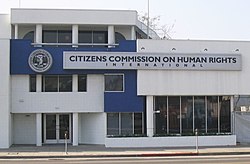公民人权委员会
 | |
 公民人权委员会洛杉矶总部,2005年 | |
| 原名 | Citizens Commission on Human Rights |
|---|---|
| 成立时间 | 1969 |
| 创始人 | 托马斯·萨斯、山达基教会 |
| 法律地位 | 非营利组织 |
| 地址 |
|
| 坐标 | 34°05′51″N 118°20′02″W / 34.0976°N 118.334°W |
收入 | 3,248,871 美元 (2016年) |
| 捐款 | 3,197,251 美元 (2018年) |
| 目标 | 反对和取消精神科 |
| 网站 | cchr 台湾社团法人中华公民人权协会 CCHR |
公民人权委员会(英语缩写为:CCHR)也称公民人权协会,由山达基教会与美国精神病学家汤玛士·萨兹博士于1969年在美国成立,山达基教会资助和经营[13]。该组织总部坐落于美国洛杉矶,自称其目的是消除精神病学的不人道行为及虐行,实际目的是否定精神病的存在,并消除整个精神科医学领域,以山达基的方法取而代之[14]。大多数非山达基教徒视其为山达基教的掩护团体,其目的是推动教会的反精神病学议程。
公民人权委员会在台湾的分会为成立于2012年的中华公民人权协会,该组织在台湾积极宣传1960年代以前的陈旧精神病学问题,以及诊断错误的例子,藉以攻击整个精神科医学[15]。至于在心理干预之后,该组织提供的方案则多为山达基教会的外围机构的精油、排毒、磁疗、超剂量维他命疗法等非实证医疗的边缘疗法[16][17]。
协会对精神病的看法
[编辑]公民人权委员会对精神病学的看法,直接反映了新兴宗教山达基教创始人L·罗恩·贺伯特的立场,其作品非常强烈地表达了反精神医学的观点。根据贺伯特的认知,所有精神科医生都是罪犯[18]。
虽然公民人权委员会陈述其创会宗旨是“调查和揭露精神科违反人权”,但在山达基自己内部的募款出版物上,其目标是完全消除“身心性疾病”这个词汇,并请成员实现这一目标:“参加消除精神病的团队”、“现在该是制止精神病学和它的犯罪行为的时候了”、“消除精神科医生正是公民人权协会正在做的事!”。[19]
此内外宣传的差异引起许多人批评指出“公民人权委员会”其实是山达基教的掩护团体,目的是推广山达基反精神科医学的教义[1]。
活动
[编辑]“精神病学:死亡工业”
[编辑]
2005年12月,公民人权委员会在好莱坞日落大道上开放了“精神病学:死亡工业”博物馆。[20][21]
中华公民人权协会在台湾高雄也策展“精神病学:死亡工业”,对精神病学进行抹黑宣传[15][22]。
相关条目
[编辑]参考资料
[编辑]- ^ 1.0 1.1 Industry of Death exhibition on psychiatry walks a fine line. Canada.com. 8 August 2007 [23 September 2012]. (原始内容存档于2011年6月15日).
“A major purpose of Scientology is to destroy psychiatry and replace it with its own pseudo-counselling techniques. And CCHR is one of Scientology’s front-group weapons attempting to achieve that goal,” says Stephen Kent, a University of Alberta sociologist specializing in new religions and cults. Scientology holds that psychiatrists are “cosmic demons,” he says.
- ^ Kirsten Stewart. Scientology's political presence on the rise. The Salt Lake Tribune. 2 July 2005 [23 September 2012]. (原始内容存档于2014年7月14日).
The church [of Scientology] kept a low profile, paying professional lobbyists to press its cause or relying on CCHR, which skeptics call a front group designed to recruit Scientologists and replace psychiatry with Dianetics.
- ^
[ Fence Post ]. Chicago Daily Herald (Letters to the Editor). 4 January 2001.
Dangerous program / In a letter to Fence Post (Dec. 12), Susan Stozewski of the Chicago Church of Scientology attempts to promote a drug rehab program called Narconon. I wish to warn readers that Narconon is a front group for the Church of Scientology. I found from personal experience that Narconon is a sham and is, in fact, a slick device to lure unsuspecting people into Scientology. An acquaintance of mine recently discovered that she had serious liver damage from Narconon's bogus "purification" program and she now cannot get health insurance coverage. Another Scientology front group to beware of is the CCHR or Citizens Commission on Human Rights. The CCHR is using tax-exempt funds in a covert campaign to discredit psychiatric-psychology treatment. The CCHR has an extensive network of agents that are distributing distortions about psychiatric treatment and medications such as Prozac and Ritalin. This is a very dangerous thing and people should be aware that it is going on. / Jim Beebe / Northbrook
- ^
U.S. Food and Drug Administration rejects Scientologists' petition. Business Wire (reprinting Eli Lilly press release). 1 August 1991.
The petition sought the removal of Prozac (fluoxetine hydrochloride, Dista) from the market and was filed in October 1990 by the Citizens Commission on Human Rights (CCHR), a Scientology front group. The FDA is to be commended on its careful review of pertinent scientific data, which led to this most recent reaffirmation of the safety and effectiveness of Prozac. From the start, the campaign against Prozac, of which the CCHR petition was a part, has been a dangerous deception. Scientology's disinformation is a menace to the public health as it attempts to frighten patients away from appropriate medical care and safe and effective medicines.
- ^
'Church' that yearns for respectability; Business of religion; Scientology. The Times. 23 June 2007.
Hubbard's empire ... Citizens' Commission on Human Rights: assets £4,000; turnover £43,000
- ^
The Scientology Church of Hollywood. The Globe and Mail. 11 September 1993.
Scientology's physical presence in Los Angeles and Hollywood is massive. It owns at least seven large buildings, staffed by 2,500 members, and is associated with a wide array of local organizations - "front groups" to their detractors. Some are directly affiliated, like the Citizens' Commission on Human Rights, an anti-psychiatry group, and Author Services, which represents Mr. Hubbard's books and hires actors like Roddy McDowall and Bruce Boxleitner to read the Scientology founder's books on tape. Others have Scientologists on staff and use church methods.
- ^
Scientology's War Of Retribution On Deep-sleep Therapy. The Age. 22 April 1991.
Internal documents from the Church of Scientology, the parent organisation of the Citizens Commission on Human Rights, indicate that behind the church's public battle to expose abuses of psychiatric patients lies a hidden plan of retribution.
- ^
Scientology organizations. Charleston Gazette. 10 July 2005.
Scientology operates several drug rehab, education and anti-psychiatry organizations. / · Narconon: The church's drug-rehabilitation program was founded 35 years ago. It has 145 centers in 38 countries. Narconon is based partly on Scientology's belief that drugs accumulate in body fat. / · Crimonon: A prison program founded in 1972 that draws on Scientology principles to rehabilitate prisoners. The program rejects traditional mental-health care. Hubbard believed that Scientology could help rid the planet of crime. / · Citizens Commission on Human Rights (CCHR): Established in 1969 as an anti-psychiatry organization, CCHR promotes Hubbard's teachings against modern psychiatry. It charges that psychiatry has no scientific foundation, that psychiatric drugs cause violent behavior and that chemical imbalances have never been proven.
- ^ Scientology faces wave of cyber attacks. Cape Times. 4 March 2008 [23 September 2012]. (原始内容存档于2017-06-22).
- ^ Fink, Max. Ethics in Electroconvulsive Therapy. Philadelphia: Brunner-Routledge. 2004: 12. ISBN 0-415-94659-X.
- ^ Thompson, Marie. Mental Illness. Westport, Conn: Greenwood Press. 2007: 96. ISBN 0-313-33565-6.
- ^ Benjamin, Gedan. Bill Would Curtail Presecriptions for Mentally Ill. The Boston Globe.
- ^ [1][2][3][4][5][6][7][8][9][10][11][12]
- ^ Frantz, Douglas. An Ultra-Aggressive Use of Investigators and the Courts. New York Times. 1997-03-09 [2008-10-21].
- ^ 15.0 15.1 「精神病學:死亡工業」巡迴展於高雄巨蛋廣場圓滿落幕,近兩千人到場參觀 | 中華公民人權協會的沙龍. vocus.cc. 2024-05-04 [2024-11-01] (中文(繁体)).
- ^ 教育資源. 台湾社团法人中华公民人权协会 CCHR. [2024-11-01] (中文(台湾)).
- ^ 以陳舊觀點反對現代精神醫療,意圖為何?. 台湾儿童青少年精神医学会. [2024-12-28] (中文(台湾)).
- ^ 贺伯特, L·罗恩. 犯罪和精神病. 1969 [2006-06-12]. (原始内容存档于2006-06-19) (英语).
- ^ 杰夫雅各布森. 人權組織攻擊「敵人」. 2004 [2008-11-04]. (原始内容存档于2020-07-13) (英语).
- ^ 安德鲁冈贝尔, "科学神教与科学 (页面存档备份,存于互联网档案馆)," 洛杉矶市节奏, 06年1月12日
- ^ "娱乐今夜 (页面存档备份,存于互联网档案馆)," 有线电视新闻网, 12月20日2005年
- ^ 公民人权协会 (CCHR Taiwan 公民人权委员会 台湾分会). 2024年4月26-28日 【現代瘋狂之起源,精神健康與你的生活】-「精神病學:死亡工業展」. 台湾社团法人中华公民人权协会 CCHR. 2024-04-11 [2024-11-01] (中文(台湾)).
外部链接
[编辑]- 公民人权委员会官方网站 (页面存档备份,存于互联网档案馆)(英文)
- 台湾社团法人中华公民人权协会 CCHR
